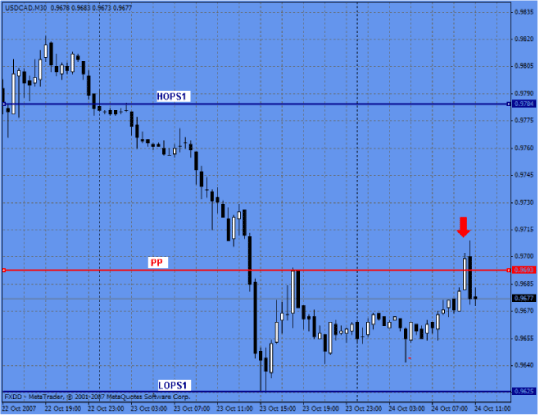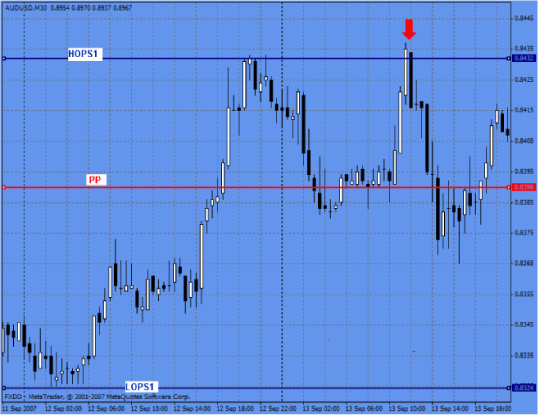Using PP, HOPS’s and LOPS’s as a Trading Indication
As mentioned before, these levels have a high probability of behaving as a reaction point. The market might reverse from these levels, retrace from them, or the market could stalk at these levels or break through them with strength. We will see different scenarios.
Using these levels by themselves to take trading decisions is somewhat risky and will not necessarily give the consistent results we are looking for. We need to combine these levels with price behavior so our signals become stronger and more effective.
The most common use of these levels is to trade when the market bounces from these levels and price behavior suggests a new direction is beginning.
We look for reversal or strong continuation patterns/behavior that meet the candlestick price behavior patterns discussed earlier. Note reversal patterns need to be (when ranging) at the top or the bottom of the range and when trending in retracements off important levels.
For a reversal pattern to be valid there has to be a market movement to reverse….and something to reverse off which is where the mapping levels come into play…..
When we combine price behavior and mapping we start to see some really interesting and consistent results – take a look at the charts below and also browse your own charts and you will quickly see exactly what we mean
1. A trade off HOPS in direction of the trend

[Chart 1]
Right at the beginning of the session the market breaks HOPS1 (showing us a strong uptrend, therefore we only look for long trades). After a couple periods, the market retraced to HOPS1 and forms a beautiful bullish piercing pattern triggering our long signal.
As the previous session ends, the market goes down early and breaks the HOPS1 level. Then, a piercing pattern is formed across HOPS1; this shows us that the market sentiment is still bullish by triggering our signal. When the market is above HOPS it is considered to be in a strong uptrend, indicating there is still a good possibility that the market will reach higher levels, in this case we use a RR of 2:1.
If the market was trading above HOPS1 and 2 we would use 3:1 to capitalize on greater likelihood of strong trending
2. A trade off the PP in direction of the trend

[Chart 2]
The whole session traded below the PP, this tells us the sentiment is bearish, and a possible downtrend could be developing. We use a RR ratio of 2:1 as per our mapping rules as we are not certain a trend is developing even though we have a strong indication. The bearish engulfing pattern off the PP would have signaled our trade. There is a shooting star seen a few candles previously but as this is not off an important level we disregard it
3. A trade off HOPS1 against the possible trend

[Chart 3]
At this chart, the market trades below the PP right after the session begins, but it after a reversal hammer goes back above PP and generates a great reversal off HOPS1 against the trend. After a while, it breaks through the PP level and comes back again quickly (after a shooting star). This gives us a hint that the market could possibly range.
Here we use a RR ratio of 3:1, because although it can range the trade is against the trend so we protect ourselves against the increased risk using a higher RR.
Generally speaking, trades that are taken in direction of the trend have a higher probability of success than those taken against the possible trend. The riskier it is, the more we should be able to make in such trade. If we had taken this trade, short at 0.8416 our stop loss could be placed at 0.8440 then our target should be placed around 0.8340, as you can see our target wouldn’t have been reached. Even so this trade would have been profitable as we would have closed on seeing that large shooting star against our trade at 0.380 giving us 30-35 pips
We hope these charts illustrate the rationale behind the selection of RR in a real world environment. Careful use and selection of RR in conjunction with good money management will allow you to maximize the good opportunities the system will provide and lessen the damage done by errant trades.